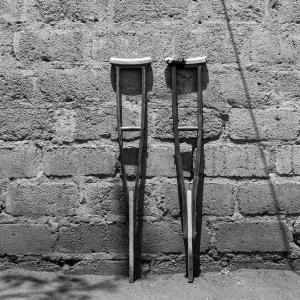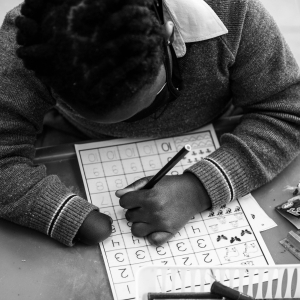The 2011 “World Report on Disability” shone a spotlight on the high prevalence and diverse needs of persons with disabilities. The 2006 Convention on the Rights of Persons with Disabilities (UNCRPD) called for governments to empower those with disabilities and collect disability-related data. The 2015 Sustainable Development Goals called the world to leave no one behind, including persons with disabilities and migrants. The 2018 Global Compact for Safe, Orderly and Regular Migration called for disability-responsive approaches to migration.
Despite these important developments, we still do not know enough about migration and disability.
Disabilities affect more people than we may expect – around 15% of the population. The rate for migrants can be much higher in some settings, but a lack of data means we do not know for sure. Without quality and timely data on migrants with disabilities, we cannot understand their situation and know what changes to policy are needed to remove accessibility barriers. As we know, if people are not counted, they often do not count.
In celebration of International Day of Persons with Disabilities, the IOM Global Migration Data Analysis Centre hosted a webinar to hear from various experts on the state of migration and disability data. Speakers addressed progress made, existing challenges and ways forward. They also presented findings from emerging practices, innovative projects and relevant tools to help others in this field. Read on for highlights from the four speakers during the recorded webinar.
Definitions and tools
Disability can be defined as the result of the interaction between someone’s medical condition and impairments or mental health conditions, barriers in the environment and personal factors. Simone Holladay from IOM’s Displacement Tracking Matrix (DTM) explained how barriers can include a lack of accessibility, other people’s negative attitudes, stigma, lack of regulations, and other factors. Personal factors can include things like someone’s gender, financial situation, migratory status, religion, education, or what neighbourhood they live in.
When a person with a disability is also a migrant or forcibly displaced person, there can be increased vulnerability across areas of life – from school attendance to sexual violence. Forced displacement in particular increases exposure to violence and injury, which increases individual vulnerability. It also often worsens existing disabilities, increasing the risk of compounded injury or additional barriers to access services and participate in society. Therefore, forced displacement can increase prevalence rates of those with a disability. One study found that over eight years of forced displacement in Syria, 25% of people over the age of 12 have a disability.
Data on disability and forced displacement is critical. This can help address people’s needs – for example, data is needed to build the right number of accessible latrines in camp or camp-like settings for internally displaced people (IDPs).
Data is needed on both the prevalence of disabilities and barriers and risks that affected people face. Prevalence can be complex to compute, and the Washington Group questions have been progressively used to assess this. Data on barriers includes information on physical, attitudinal and communication barriers faced by persons with functional disabilities. This type of data is usually collected from key informants.
DTM, UNHCR, UNICEF, Humanity and Inclusion, and Oxfam teamed together to develop toolkits to support data collection on this. The DTM Partners Toolkit: Field Companion for Disability Inclusion provides guidelines on how to collect data to better understand the barriers and risks persons with disabilities face in humanitarian emergencies with high mobility. This includes questions about disability barriers and risks that can be used widely. Questions are structured along different functional barriers, exploring how someone’s different abilities in seeing, walking and communicating affects, for example, how they interact with health services. Further, the the IASC Guidelines on Inclusion of Persons with Disabilities in Humanitarian Action provides insight into essential actions that humanitarian actors must take in order to effectively identify and respond to the needs and rights of persons with disability.
Cross-sectoral partnerships
Sometimes there is a need to "do data differently." Jo Vearey from the African Centre for Migration & Society at Wits University presented findings from an innovative scoping exercise which used different types of data to explore mobility and disability in South Africa. The project combined remote interviews, policy analysis, desk research and photos by journalists. Facing COVID-related restrictions that limited face-to-face contact, in their research project Wits University and IOM South Africa teamed up with journalists who were permitted greater mobility. This resulted in including a related photojournalism project.
In a context where the intersection between migration and disability is neglected in policy and programming, the project sought to address the related lack of available data on migrants with disabilities in South Africa. This resulted in a textured exploration of several members of this community. This includes several personal data stories including that of Hope (pictured) who was born without a right hand.
There is a need to strengthen data on the topic. Currently, key stakeholders involved in service provision to migrants with disabilities in South Africa do not disaggregate their data effectively – disability actors do not disaggregate by migratory status, and migration-related actors do not disaggregate by disability status. Moving forward, research projects need to meaningfully include migrants with disabilities themselves, to promote inclusion, increase quality of data collected and boost trust with respondents. This project helps conceptualise ways to work across sectors to collect different types of data creatively.
Regional and thematic deep dives
Diana Hiscock from HelpAge International presented findings from a regional assessment on the situation and needs of older persons on the move in Latin America, by UNHCR and HelpAge International. The project addressed a specific regional data gap – older migrants including asylum seekers, returnees, IDPs and deportees.
The report A claim to dignity: Ageing on the move includes data from telephone interviews in El Salvador, Honduras, Ecuador, Peru, and Colombia. Through personal stories, this demonstrates how migration and disability linked to older age interact to impact people’s lives. For example, it explores effects on employment opportunities. Some participants are not able to undertake informal physical labour due to their medical condition and face legal difficulties accessing formal labour markets which may hold more appropriate jobs due to their refugee status. In many cases this compounded vulnerability leads migrants living with disabilities into destitution.
43% of the older people included in the project’s survey have a disability – issues related to physical mobility and vision were the most common. Unemployment was high among participants. 82% reported they faced some form of discrimination. Many had related health challenges and 42% have not received medical treatment for these. Two thirds required support with daily life and many do not receive it.
Such reports serve as a start call to action to leave no one behind. To do so, we need better data on different population sub-groups. One concrete way to improve data collection on disability and older age is to ensure that age cohorts in studies include 60-69, 70-79 and 80+ to better understand the diversity within the older age groups over their life course.
Open humanitarian data
Persons with disabilities often experience hazards differently. In a humanitarian emergency, people with disabilities are often among those most in need of assistance. For example, they can be at high risk of violence, exploitation or abuse. Data on these people allows policymakers to better understand and address their needs, target humanitarian assistance efficiently and integrate protection concerns into programming. If such needs are not included in analysis, they cannot be included in programming.
Javier Teran from OCHA’s Centre for Humanitarian Data showcased some datasets shared by partners on the Humanitarian Data Exchange (HDX) on mobility and disability of IDPs that can be leveraged for analysis and policy use. HDX, an open humanitarian data platform, includes data about the context in which a humanitarian crisis is occurring; data about the people affected by the crisis and their needs; and data about the response by organisations and people seeking to help those who need assistance. About 470 of HDX’s approximately 18,600 datasets include some disaggregation by disability status of affected populations, generating insightful data in many countries such as Afghanistan or Iraq. Humanitarian Needs Overview reports often contain disability estimates in humanitarian settings, though these usually do not disaggregate by sex, age, migratory status or other dimensions.
During the session, there was consensus that there is a need to collect more primary data on mobility and disability. Recognised approaches such as the Washington Group questions can be used for this purpose. Further, datasets with gender, age and/or disability status disaggregation must be managed in a safe and ethical way so the identity of affected people can be protected.
Conclusion
More data on migrants with disabilities is fundamental to their full and equal participation in society. Better access to basic services, less discrimination and more opportunities can only happen with more information.
This has been a neglected area of work in the data field, and GMDAC aims to address this critical topic moving forward, sparking more discussion and action on addressing the remaining challenges to improving disability-inclusive data on migration.






